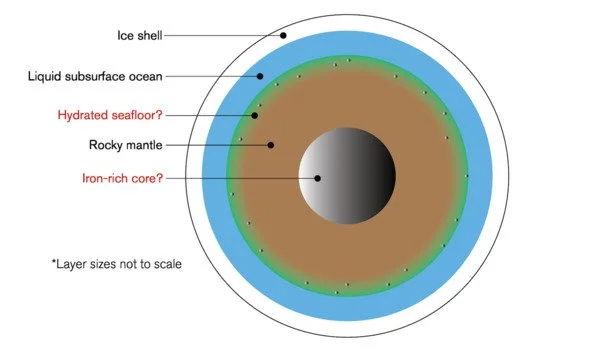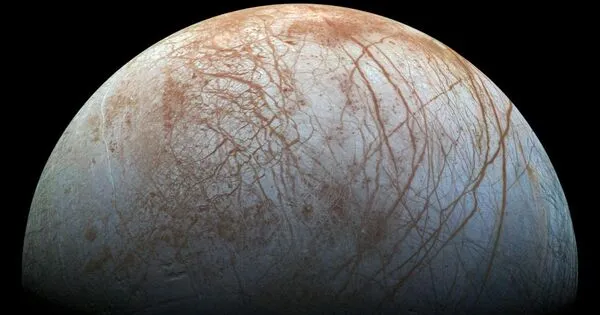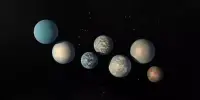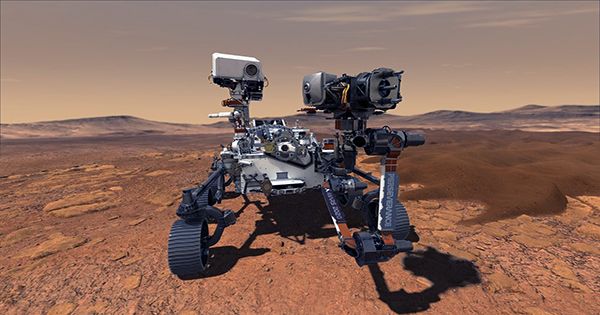The presence of this subsurface ocean, combined with evidence of geological activity such as fractures, ridges, and other surface features, indicates that Europa has a dynamic geological history. Tidal forces from Jupiter’s gravity cause flexing and heating of the moon’s interior, potentially leading to a slow and continuous evolution over time.
Europa’s ocean may have a metamorphic origin. While some scientists speculated on this, a research team found that if Europa was formed from hydrated rocks (rocks that contain hydrogen and oxygen), then enough of Europa’s interior should have gotten hot enough to release water directly from the hydrated rocks, forming the ocean and ice shell.
Jupiter’s moon, Europa, is slightly smaller than Earth’s Moon and is one of the most promising places to search for alien life.
Scientists are particularly interested in Europa in the Jovian system because of the strong evidence for nutrients, water, and energy that could potentially provide a habitable environment for some form of life beyond Earth. Furthermore, Europa is thought to be composed of four layers (from surface to core): an ice shell, a salt water ocean, a rocky mantle, and a metallic core.
Europa’s ocean, like Earth’s, touches the rocky seafloor, which may allow for favourable rock-water chemistry for life. Some scientists believe that volcanoes on the seafloor could provide more energy and nutrients to a potential biosphere.
ASU scientists Kevin Trinh, Carver Bierson and Joe O’Rourke of the School of Earth and Space Exploration investigated the consequences of Europa forming with low initial temperatures, using computer code that Trinh wrote. Their findings have been recently published in Science Advances.
The origin of Europa’s ocean is important because the moon’s potential to support life ultimately depends on the chemical ingredients and physical conditions during the ocean formation process.
Kevin Trinh
Hydrated rocks may be a key ingredient
Europa’s ocean may have a metamorphic origin. While some scientists speculated on this, Trinh and his colleagues show that if Europa was formed from hydrated rocks (rocks that contain hydrogen and oxygen), then enough of Europa’s interior should have gotten hot enough to release water directly from the hydrated rocks, forming the ocean and ice shell.
“The origin of Europa’s ocean is important because the moon’s potential to support life ultimately depends on the chemical ingredients and physical conditions during the ocean formation process,” said Kevin Trinh, graduate associate at Arizona State University’s School of Earth and Space Exploration.

Metallic core formation requires high temperatures
Many researchers studying Europa assumed that it formed with a metallic core during or shortly after accretion. This ASU study contradicts that prediction, arguing that Europa’s metallic core may not have formed until billions of years after accretion.
“We tend to think of most worlds in the solar system’s internal structure as being set shortly after they finish forming. This work is extremely exciting because it reframes Europa as a world whose interior has slowly evolved over its entire lifetime. This paves the way for future research into how these changes might be observed in the Europa we see today,” said Carver Bierson, a postdoctoral research scholar at ASU’s School of Earth and Space Exploration.
The presence of a metallic core is inextricably linked to Europa’s internal heat, which may also drive seafloor volcanism and contribute to a habitable seafloor environment. It is unknown, however, whether Europa generated enough heat to form such a core. Trinh’s code calculates how heat is generated and distributed across a moon by employing the same governing equations that many geodynamicists have used for decades. The team’s novel result, on the other hand, comes from challenging the assumptions that are common in Europa modelling: Europa, a small moon, could form as a cold mixture of ice, rock, and metal.
All of these processes, however, necessitate a hot interior. A small moon like Europa (1% of Earth’s mass) may lack the energy to initiate or sustain Earth-like processes such as metallic core formation, seafloor volcanism, and ongoing rock-water geochemistry, implying that Europa’s habitability is uncertain. The precise time Europa formed determines how much heat is available from the radioactive decay of a short-lived aluminium isotope. The rate at which Europa’s interior separates into distinct layers is also governed by tidal heating (caused by gravitational interactions with Jupiter and other moons).
















